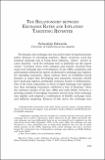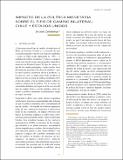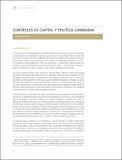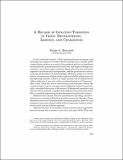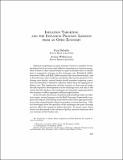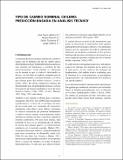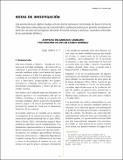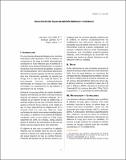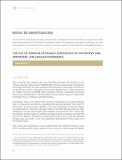Search
Now showing items 1-10 of 69
The relationship between exchange rates and inflation targeting revisited
For decades, the exchange rate was at the center of macroeconomic policy debates in emerging markets. Many countries used the nominal exchange rate to bring down inflation, –others—mostly in Latin America—used the exchange rate to implicitly tax the export sector. Currency crises were common and usually ...
Impacto de la política monetaria sobre el tipo de cambio bilateral: Chile y Estados Unidos
Este artículo analiza la reacción del tipo de cambio entre pesos Chilenos y dólares estadounidenses a las medidas de política monetaria que se adoptan en Chile y Estados Unidos. Se corre una regresión a la variación del tipo de cambio frente a un anuncio de política, sobre la variación de la tasa de ...
Controles de capital y política cambiaria
El análisis empírico de este estudio sugiere que un objetivo de política cambiaria y el temor de un sobrecalentamiento de la economía nacional han sido los dos motivos más importantes para la (re) introducción y persistencia de los controles de capital de la última década. Los controles de capital se ...
Inflation targeting in Brazil: shocks, backward-looking prices, and IMF conditionality
In mid-January 1990, Brazil abandoned its crawling exchange rate band. Surprisingly enough, the country's economic performance in the aftermath of this episode was much better than expected, given the performance of other emerging market economies after a move toward floating. Despite the large ...
A decadeof inflation targeting in Chile: developments, lessons, and challenges
In the twentieth century, Chile experienced most monetary and exchange rate regimes. Periods of fixed exchange rates usually ended in speculative attacks as a result of inconsistent policies or significant external shocks, generating serious real costs and larger exchange rate volatility.
Inflation targeting and the inflation process: lessons from an open economy
Inflation targeting in an open economy insolves a number of complexities that do not arise with inflation targeting in a clises economy. One of these is that central banks in open economies have to decide how to repond to changes in the exchange rate.
Tipo de cambio nominal Chileno: predicción basada en análisis técnico
Este trabajo presenta un resumen de las principales medidas utilizadas en el análisis técnico de la paridad peso-dólar. Se explica la interpretación y el uso que los analistas técnicos dan a estas medidas. Asimismo, se realizan ejercicios que evalúan la capacidad del Índice de Fuerza Relativa (RSI) ...
Actividad del mercado cambiario y movimiento del tipo de cambio nominal
Esta nota presenta evidencia — basada en series nuevas de actividad cambiarla— del efecto de los volúmenes y posiciones de distintos agentes del mercado cambiario sobre el movimiento del tipo de cambio nominal en Chile. En particular, se evalúa si medidas de actividad de los mercados cambiarlos spot ...
Relación entre tasas de interés internas y externas
En una economía altamente integrada a los mercados financieros internacionales como la chilena, las variaciones de las tasas de interés internacionales constituyen un factor relevante para el análisis de la evolución de las tasas de interés locales. En ausencia de barreras a los movimientos de capitales, ...
The use of foreign exchange derivatives by exporters and importers the Chilean experience
This research note analyses the use of foreign exchange (FX) derivatives by Chilean exporters and importers (EXIM) that conduct international transactions in foreign currencies. It seeks to answer the questions of how many derivatives are used, how are they used and what are their characteristics. ...

